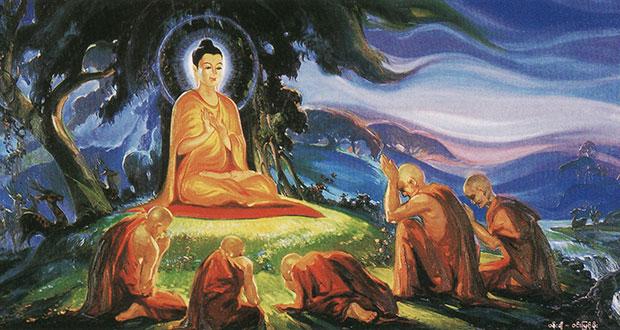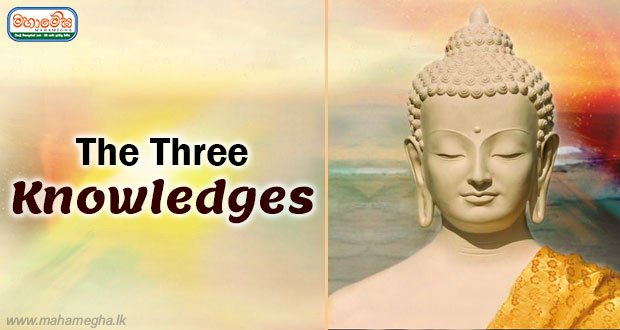In previous articles we discussed the first, second and third Noble Truths. The first noble truth is suffering. Which is birth, aging, sickness, death, sorrow, lamentation, pain, grief, despair, association with what we dislike, disassociation with what we like, not getting what we want and the five aggregates of clinging. We learnt the second noble truth as being the cause of suffering; which is desire. As long as desire exists in our mind it gives rise to ill will, anger, jealousy, deceit, fraud, rivalry, conceit and numerous other defilements which in turn cause suffering relevant to each defilement. The third Noble Truth is cessation of suffering, which is eradication of desire; the cause of suffering and attaining nibbana.
In this article we will be discussing the Fourth Noble Truth, the path leading to the cessation of suffering; the Noble Eightfold Path. The one and only way to achieve enlightenment by eradicating the whole mass of suffering is by practicing the Noble Eightfold Path. If any person regardless of his race or creed practices this noble path in accordance with the teachings of the Buddha he would indeed reap the benefits by attaining the fruits of the path; stream entrant, once returner, non-returner and arahantship.
The Noble Eightfold Path consists of eight tenets. Which are right view, right intention, right speech, right actions, right livelihood, right effort, right mindfulness and right concentration. The first of these eight tenets, right view, is achieved by realizing the Four Noble Truths. The wisdom gained by a disciple by realizing the Four Noble Truths is known as sacca-ñāṇa. Once he has acquired this wisdom he understands that the Four Noble Truths are an absolute and definitive truth that exists in the world. Thus he has attained the first fruit (result) of the path, which is stream-entrant.
Stream-entrant or Sothapanna disciple is one who has acquired the right view, the first tenant of the Noble Eightfold Path. As implied by the word stream-entrant a person who has attained this level has entered the “stream” which inevitably flows to nibbana. The “stream” is none other than the Noble Eightfold Path. He/she is guaranteed to achieve full awakening within seven life times at most, and in the interim will not be reborn in the four bad destinations.
Having acquired sacca-ñāṇa; the wisdom of knowing that the Four Noble Truths are an absolute and definitive truth, the sothapanna disciple has two more steps to complete in fully comprehending the Four Noble Truths. Which are kicca-ñāṇa and kata-ñāṇa.
kicca-ñāṇa is the wisdom of knowing what has to be done with regard to each noble truth. The noble truth of “suffering” has to be realized. As per the teachings of Lord Buddha the internal faculties; eye, ear, nose, tongue, body, mind and external faculties; forms, sounds, smells, tastes, tangibles, mental objects, the four elements, the five aggregates of clinging; forms, feelings, perception, volitional formations, consciousness, all these belongs to suffering. Yet because of our ignorance we consider these to be sources of happiness. By practicing the Noble Eightfold Path we develop our wisdom to see the true nature of these things, which is they are impermanent, suffering and non-self and relinquish the desire for all these phenomena.
Then the noble truth of “cause of suffering” has to be eradicated. Therefore desire or craving which is the cause of suffering has to be eradicated. Then the third noble truth “cessation of suffering” has to be attained and the fourth noble truth “the path leading to the cessation of suffering” has to be developed.
With the objective of achieving these goals the sothapanna disciple continues practicing the noble eightfold path. Based on his/her faculty of right view, also known as “dhammachakku” or “the eye of dhamma” he accurately discerns the right from the wrong, the wholesome from the unwholesome. Having discerned what is wholesome and unwholesome, with the application of right effort and right mindfulness he abandons wrong intention and develops right intention, abandons wrong speech and develops right speech, abandons wrong action and develops right action, abandons wrong livelihood and develops right livelihood. In this manner he continues to develop the other aspects of the noble path based on right view, right effort and right mindfulness which culminates with developing the eighth and final tenant of the path; right concentration. Right concentration is fulfilled once the first, second, third and fourth jhana stages have been achieved.
During this gradual development of the Noble Eightfold Path within the sothapanna disciple, he develops both his mind and wisdom which leads to the progressive eradication of desire. Once the desire for sensual pleasure abates he becomes a once-returner, once the desire for sensual pleasure is eliminated he becomes a non-returner and with the total eradication of the desire for sensual pleasure, desire for existence and desire for non-existence he achieves enlightenment and becomes an arahant.
He has now fully developed the Noble Eightfold Path within himself and fully comprehended the Four Noble Truths and achieved kata-ñāṇa. Kata-ñāṇa is the wisdom of knowing that all that needs to be done with regard to the Four Noble Truths have been accomplished. The noble truth of “suffering” has been realized, the noble truth of “cause of suffering” has been eradicated, the noble truth “cessation of suffering” has been attained and the noble truth of “the path leading to the cessation of suffering” has been developed.
In this manner a practitioner enters the Noble Eightfold Path by achieving right view and completes the path with the achievement of right concentration. Thus with the completion of the Noble Eightfold Path he becomes an arahant. With the achievement of arahantship he gains two more aspects of realization. Which are samma-ñāṇa and samma-vimutti.
Samma-ñāṇa is the wisdom of knowing that: sacca-ñāṇa; the wisdom of knowing that the Four Noble Truths are an absolute and definitive truth, kicca-ñāṇa; the wisdom of knowing what has to be done with regard to each noble truth and kata-ñāṇa; the wisdom of knowing that all that needs to be done with regard to the Four Noble Truths have been accomplished, has been attained and there is nothing else to be done in that respect. Samma-vimutti is the realizing that the truth of suffering has been fully comprehended, the craving from which suffering springs has been eradicated, and realizing with complete clarity the unconditioned element, Nibbana, the cessation of suffering has been attained.
Therefore samma-vimutti is experiencing Nibbana by having walked the Noble Eightfold Path to its end and living in the assurance stated so often in the suttas of the Pali canon: “Destroyed is birth; the holy life has been lived; what had to be done has been done; there is no coming back to any state of being.” The arahant is no longer a practitioner of the path but its living embodiment. Having developed the eight factors of the path to their consummation, the Liberated One lives in the enjoyment of their fruits, enlightenment and final deliverance.
By a Venerable Thero of Mahamevnawa Meditation Monastery.












Sadhu sadhu sadhu